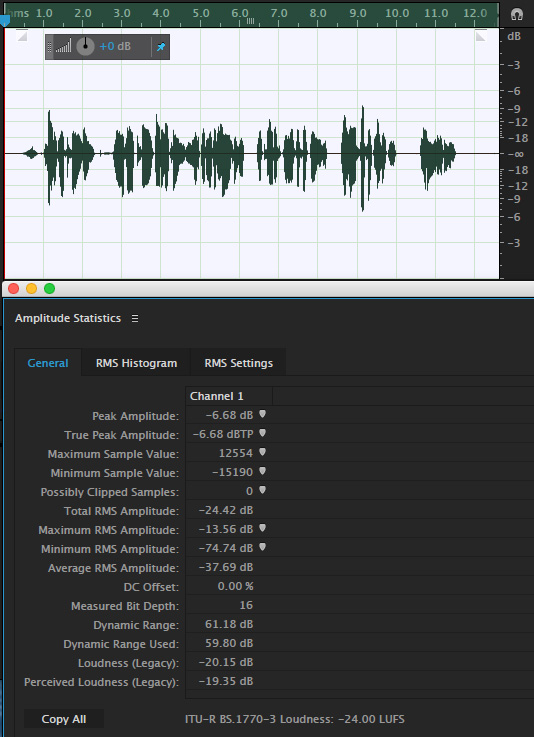

LU is an abbreviation for Loudness Units, a relative measure of loudness and an attempt to have a more traditional number to work with. For broadcasters using this standard, the program target loudness of audio is -23 LUFS.īoth LKFS and LUFS are equivalent, and one unit is equal to one decibel. It too is an absolute measure of loudness. It is used in the European EBU R128 standard.
Adobe audition normalize volume full#
LUFS is an abbreviation for Loudness units relative to full scale. For broadcasters using this standard, the program target loudness of audio is -24 LKFS. It is used in the ITU BS.1770-3 standard and ATSC A/85 standard. LKFS is an abbreviation for Loudness, K-weighted, relative to full scale. If you haven’t heard about loudness normalization you are probably asking what does LKFS stand for and what does LUFS mean? LKFS, LUFS, LU and Program Loudness This loudness standard has units to measure the loudness, and they are LKFS, LUFS, and LU. Don’t worry, the last two are based on ITU 1770-3. But you may also come across ATSC A/85 and EBU R128. You may hear the standard referred to as ITU BS.1770-3. The European Broadcasting Union (EBU) then suggested a revision. To take account of the way people perceive loudness the International Telecommunications Union (ITU) developed a standard for loudness. So, although you keep the peak levels the same, you could make your audio sound louder by boosting certain frequencies and adding dynamic range compression. Loudness also depends on the equalization of your audio and dynamic range compression. Loudness is the volume of sound that a person feels, and it is the average sound level rather than the peak levels. If you would like to dive into more detail, check out my post, what is a decibel in an audio recording. Unfortunately, the decibel can be a little confusing. The “decibel” is often used to describe the level or loudness of a sound. You see, the better the viewer experience the longer they will watch, and the more likely YouTube will place your video higher in the search results. That includes getting your audio as good as possible. Unless you are the only person making videos in your niche, which is unlikely, it is important you do everything possible to keep the viewer watching. Consequently, your video could fall in the rankings. If they click away, YouTube gets the message that your video is not the best result to answer the search question. Remember, there are loads of other videos they could watch. YouTube will assume your video is a satisfactory answer to the viewer’s question.īut say someone does that search but when they play your video, they discover the audio is too quiet.
Adobe audition normalize volume how to#
If people search for, “ how to make candles“, and they watch all your video about making candles, that sends a powerful message.

It is used to help answer whether a video answers the viewer’s search question. One of the most important metrics for YouTube is Watch Time. Ultimately, that could harm your search ranking if YouTube sees viewers bouncing away from your video. Whether the audio is too loud or too quiet, the result is that you are not delivering a good viewer experience. The viewer must turn up the volume knob, which can be annoying. The result is your video may seem quiet compared to the rest in a playlist. If your audio was too quiet for YouTube’s loudness standard, YouTube does absolutely nothing to make it sound as loud as other videos that have been normalized to the YouTube loudness standard. Meanwhile, other videos with a wider dynamic will sound just as loud and sound better. By the time YouTube has normalized the loudness, your audio not only is quieter, but it also has less dynamic range. If you heavily compress the dynamic range of your audio to make it sound loud.

So, what’s the big deal about loudness on YouTube? Why does YouTube Content loudness matter? If your audio is quieter than the ideal YouTube content loudness, YouTube does not make your audio louder. If your audio is too loud, YouTube will bring it down. So, what happens when YouTube loudness normalization is applied to your audio. However, the roll-out apparently started in December 2015. If you regularly upload videos, you can easily check when YouTube audio normalization was applied to your account. This is what’s called Replay Volume Normalization or Y ouTube audio normalization.Ĭhecking my video uploads, I discovered the YouTube loudness standard started to be applied to my content sometime between 21st and 27th August 2016. To put it another way, if your video does not conform to the YouTube loudness standards, they will adjust it for you. Streaming services, including YouTube, are adjusting the loudness of uploaded content.



 0 kommentar(er)
0 kommentar(er)
